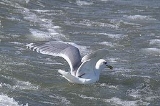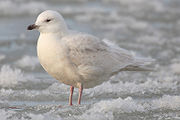
Kumlien's Gull
Encyclopedia
Kumlien's Gull, Larus [glaucoides] kumlieni, is a large gull
which breeds in the Arctic regions of Canada
. It is migratory
, wintering from Labrador
south to New England
and west across the Great Lakes
. The species is named after the Swedish-American naturalist Thure Kumlien
.
It has variably been considered a full species, a subspecies of Thayer's Gull
, a subspecies of Iceland Gull
, and a hybrid between the aforementioned species. It is currently considered a subspecies of Iceland Gull by the American Ornithologists' Union.
This taxon
breeds colonially or singly on coasts and cliffs, making a nest lined with grass, moss or seaweed on the ground or cliff. Normally, 2-3 light brown eggs are laid.
The taxon is pale in all plumages, with a remarkably variable amount of pigment in the primaries. Individuals range from completely white-winged (indistinguishable from nominate glaucoides Iceland Gull) to so much dark in the wings as to be indistinguishable from Thayer's Gull. Eye color is also variable, from pale yellow to dark brown. Such remarkable variation seems to lend credence to the belief that Kumlien's Gull is in fact a hybrid swarm
.
Kumlien's Gulls average smaller overall and much smaller-billed than the very large Glaucous Gull
and are usually smaller than Herring Gull. The taxon reaches adult plumage in four to five years. The call is a "laughing" cry like Herring Gull, but higher pitched.
 These are omnivores like most Larus gulls, and they will scavenge as well as seeking suitable small prey. These birds forage while flying, picking up food at or just below the water's surface, also feeds while walking or swimming. Their scavenging habits lead them to frequent garbage dumps, sewage outlets and places where fish are cleaned.
These are omnivores like most Larus gulls, and they will scavenge as well as seeking suitable small prey. These birds forage while flying, picking up food at or just below the water's surface, also feeds while walking or swimming. Their scavenging habits lead them to frequent garbage dumps, sewage outlets and places where fish are cleaned.
Gull
Gulls are birds in the family Laridae. They are most closely related to the terns and only distantly related to auks, skimmers, and more distantly to the waders...
which breeds in the Arctic regions of Canada
Canada
Canada is a North American country consisting of ten provinces and three territories. Located in the northern part of the continent, it extends from the Atlantic Ocean in the east to the Pacific Ocean in the west, and northward into the Arctic Ocean...
. It is migratory
Bird migration
Bird migration is the regular seasonal journey undertaken by many species of birds. Bird movements include those made in response to changes in food availability, habitat or weather. Sometimes, journeys are not termed "true migration" because they are irregular or in only one direction...
, wintering from Labrador
Labrador
Labrador is the distinct, northerly region of the Canadian province of Newfoundland and Labrador. It comprises the mainland portion of the province, separated from the island of Newfoundland by the Strait of Belle Isle...
south to New England
New England
New England is a region in the northeastern corner of the United States consisting of the six states of Maine, New Hampshire, Vermont, Massachusetts, Rhode Island, and Connecticut...
and west across the Great Lakes
Great Lakes
The Great Lakes are a collection of freshwater lakes located in northeastern North America, on the Canada – United States border. Consisting of Lakes Superior, Michigan, Huron, Erie, and Ontario, they form the largest group of freshwater lakes on Earth by total surface, coming in second by volume...
. The species is named after the Swedish-American naturalist Thure Kumlien
Thure Kumlien
Thure Ludwig Theodor Kumlien was a Swedish-American ornithologist, naturalist, and taxidermist. A contemporary of Thoreau, Audubon, and Agassiz, he contributed much to the knowledge of the natural history of Wisconsin and its birds. He collected and shipped specimens to many investigators in the...
.
It has variably been considered a full species, a subspecies of Thayer's Gull
Thayer's Gull
The Thayer's Gull is a large gull native to North America that breeds in the Arctic islands of Canada and primarily winters on the Pacific coast, from southern Alaska to the Gulf of California, though there are also wintering populations on the Great Lakes and the upper Mississippi River...
, a subspecies of Iceland Gull
Iceland Gull
The Iceland Gull, Larus glaucoides, is a large gull which breeds in the Arctic regions of Canada and Greenland, but not Iceland, where it is only seen in the winter. It is migratory, wintering from in the North Atlantic as far south as the British Isles and northernmost states of the eastern USA,...
, and a hybrid between the aforementioned species. It is currently considered a subspecies of Iceland Gull by the American Ornithologists' Union.
This taxon
Taxon
|thumb|270px|[[African elephants]] form a widely-accepted taxon, the [[genus]] LoxodontaA taxon is a group of organisms, which a taxonomist adjudges to be a unit. Usually a taxon is given a name and a rank, although neither is a requirement...
breeds colonially or singly on coasts and cliffs, making a nest lined with grass, moss or seaweed on the ground or cliff. Normally, 2-3 light brown eggs are laid.
The taxon is pale in all plumages, with a remarkably variable amount of pigment in the primaries. Individuals range from completely white-winged (indistinguishable from nominate glaucoides Iceland Gull) to so much dark in the wings as to be indistinguishable from Thayer's Gull. Eye color is also variable, from pale yellow to dark brown. Such remarkable variation seems to lend credence to the belief that Kumlien's Gull is in fact a hybrid swarm
Hybrid swarm
A hybrid swarm is a population of hybrids that has survived beyond the initial hybrid generation, with interbreeding between hybrid individuals and backcrossing with its parent types. Such population are highly variable, with the genetic and phenetic characteristics of individuals ranging widely...
.
Kumlien's Gulls average smaller overall and much smaller-billed than the very large Glaucous Gull
Glaucous Gull
The Glaucous Gull is a large gull which breeds in the Arctic regions of the northern hemisphere and the Atlantic coasts of Europe. It is migratory, wintering from in the North Atlantic and North Pacific oceans as far south as the British Isles and northernmost states of the USA, also on the Great...
and are usually smaller than Herring Gull. The taxon reaches adult plumage in four to five years. The call is a "laughing" cry like Herring Gull, but higher pitched.

External links
- Iceland Gull videos on the Internet Bird Collection
- Iceland Gull photo gallery VIREO

